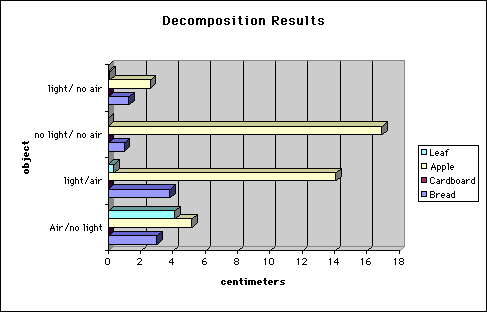
| The
objects that will receive both light and air will decompose faster than
those objects that do not get light or air.
|
|
| The
question that I decided to answer for my science fair project is "Do air
and light affect decomposition?" I chose this experiment because I found
it interesting and because decaying food can have serious effects on people's
health and decaying garbage is an important problem in many communities.
My hypothesis for this experiment is that the objects that are exposed
to both air and light will decompose faster than those objects without
air or without light. I believe that the objects left out in both air and
light will decompose faster because they are exposed to more elements,
and because I have noticed that food left out tends to become moldy.
The procedure for this experiment was to take two trays and place eight items on each: two apple slices, two pieces of bread, two pieces of cardboard, and two plant leaves. I measured the size and noted the other features of all the items at the beginning of the experiment. On each tray, one of each of these items was put in a ziploc bag. One tray was put in a dark space that gets no light, and the other tray was put on a sunny windowsill. I checked the rate of decomposition every two days for four weeks and recorded the results. In conclusion, my hypothesis was incorrect. The objects that didn't receive light but did receive air decomposed faster than the objects that received both air and light. Of all the objects, the apple slices went through the most decomposition. This experiment is useful because it showed what makes certain objects decompose and it also showed what kinds of objects decompose more quickly and how some objects decompose. |
|
|
|
|
1. Place one piece
of each of the following on a sheet of graph paper: cardboard, an apple,
bread, and a leaf. Place these items on a windowsill that gets sunlight.
2.
Place one piece of each of the following in ziploc bags and on a sheet
of graph paper: cardboard, an apple, bread, and a leaf. Place these items
on the same windowsill as the items in step 1.
3.
Place one piece of each of the following on a sheet of graph paper: cardboard,
an apple, bread, and a leaf. Place these items in the cardboard box and
cover.
4.
Place one piece of each of the following on a sheet of graph paper and
in a ziploc bag: cardboard, an apple, bread, and a leaf. Place these items
in the same cardboard box as the items in step 3.
5.
Check on the decomposition of the objects by measuring the size and taking
photographs every two days for four weeks.
6.
Record your results.
|
|

|
|
|
In this experiment, I have discovered that the objects that were not exposed to light but were exposed to air decomposed more than those objects that didn't have air and were exposed to light. The apple turned very brown, shrank, and shriveled up. The bread shrank, curled up, and became hard. The leaf turned light green and began to curl. The cardboard did not change at all. This experiment showed the effects of air and light on the decomposition of various objects. This experiment is useful because it showed how long certain things could be left out in the air or in the light and how darkness or the lack of air would affect them. From this experiment I have found that air and light do affect decomposition. |
|
|
Cobb, Vicki. Lots of Rot. New York: J.B. Lippincott, 1981. "Compost." World Book Encyclopedia. Vol. 4. Chicago: World Book-Childcraft International, Inc., 1981. "Compost." Webster's Ninth New Collegiate Dictionary. 1991. "Decay." World Book Encyclopedia. Vol. 5. Chicago: World Book-Childcraft International, Inc., 1981. "Decomposition." Webster's Ninth New Collegiate Dictionary. 1991. Hahn, James and Lynn. Recycling. New York: Franklin Watts Inc., 1973. "Landfill." Webster's Ninth New Collegiate Dictionary. 1991. Microsoft Encarta '97. Computer Software. Microsoft, 1997. Mac OS, cd-rom. "Mold." World Book Encyclopedia. Vol. 13. Chicago: World Book-Childcraft International, Inc., 1981. "Once and Future Landfills." National Geographic. Vol. 179, 1991. Ring, Elizabeth. What Rot! Brookfield: Millbrook Press, 1996. "The Wild World
of Compost." National Geographic. Vol. 158, 1980.
|
Lizzy W.
Timber Ridge Magnet School